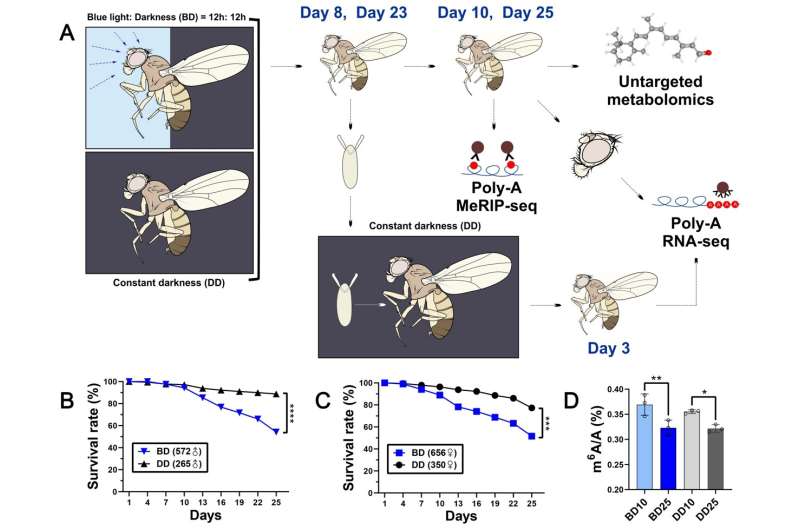This article has been reviewed according to Science X's editorial process and policies. Editors have highlighted the following attributes while ensuring the content's credibility:
fact-checked
peer-reviewed publication
proofread
Fruit fly study finds blue light exposure may affect processes related to aging

In a study on fruit flies, daily low-intensity blue light exposure (BLE), similar to that experienced daily by billions of humans in the form of LED lighting and device screens, changed flies at the sub-cellular level, affecting processes related to aging and circadian rhythms.
Xiaoyun Wang and colleagues exposed fruit flies (Drosophila melanogaster) to different durations of daily low-intensity BLE and then analyzed the consequences to the cellular makeup of the insects, as compared to flies raised in darkness. The work is published in the journal PNAS Nexus.
The authors paid particular attention to blue light's effects on N6-Methyladenosine (m6A), a modification of RNA common across the tree of life that plays a role in a wide range of processes. The authors found that blue light induced transcriptomic, m6A epitranscriptomic and metabolomic reprogramming.
Ten-day old flies could be differentiated from 25-day old flies by each age group's m6A epitranscriptomic profiles, showing the link between m6A and aging. RNA profiles between 25-day-old male blue light exposed flies' heads were significantly different from 25-day-old male dark-raised flies' heads.
According to the authors, the types of genes up- and down-regulated suggest that blue light exposure can damage neuronal function. In comparisons of whole-body transcriptomes, however, age created bigger differences between groups than light exposure, suggesting that eye and brain tissues of Drosophila are the major tissues affected by blue light.
Differences in mRNA m6A levels and other m6A-related markers between light and dark raised flies indicate that m6A methylation was involved in the impacts of BLE on Drosophila. According to the authors, attention should be paid to the potential hazards of cumulative blue light exposure in humans.
More information: Jia Huang et al, Systematic assessment of transcriptomic and metabolic reprogramming by blue light exposure coupled with aging, PNAS Nexus (2023). DOI: 10.1093/pnasnexus/pgad390
Journal information: PNAS Nexus
Provided by PNAS Nexus


















